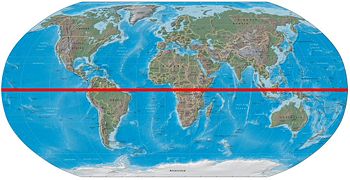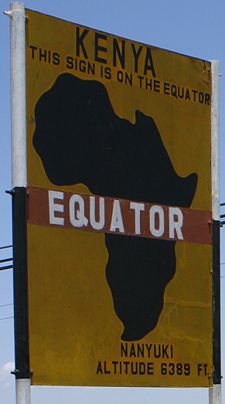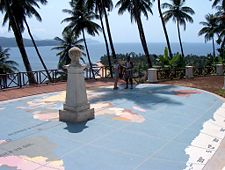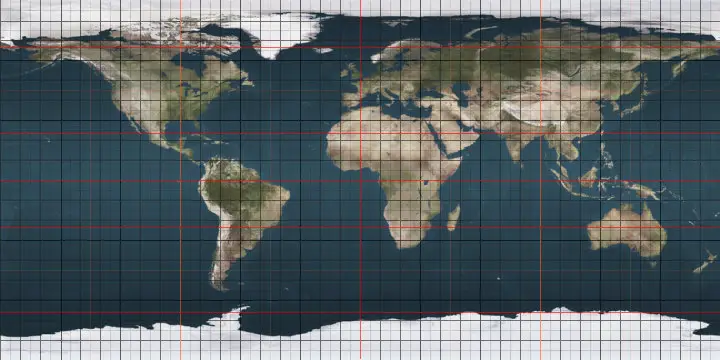Difference between revisions of "Equator" - New World Encyclopedia
Mary Anglin (talk | contribs) |
Mary Anglin (talk | contribs) m |
||
| Line 5: | Line 5: | ||
==Geodesy of the equator== | ==Geodesy of the equator== | ||
| − | |||
| − | |||
| − | |||
| − | |||
| − | |||
The [[latitude]] of the equator is, by definition, 0°. The length of Earth's equator is about {{convert|40075|km|1}}. | The [[latitude]] of the equator is, by definition, 0°. The length of Earth's equator is about {{convert|40075|km|1}}. | ||
| Line 30: | Line 25: | ||
==Equatorial countries and territories== | ==Equatorial countries and territories== | ||
| + | {{FixBunching|beg}} | ||
| + | [[Image:Equator sign kenya.jpg|thumb|225px|In tourist areas, the equator is often marked on the sides of roads.]] | ||
| + | [[Image:Equator Sao Tome.jpg|thumb|225px|The equator marked as it crosses [[Ilhéu das Rolas]], in São Tomé and Príncipe]] | ||
| + | [[Image:Equator monument.jpg|thumb|225px|A monument marking the equator at the city of [[Pontianak, Indonesia]]]] | ||
| + | {{FixBunching|end}} | ||
The equator traverses the land and/or territorial waters of 14 [[country|countries]]. Starting at the [[Prime Meridian]] and heading eastward, the equator passes through: | The equator traverses the land and/or territorial waters of 14 [[country|countries]]. Starting at the [[Prime Meridian]] and heading eastward, the equator passes through: | ||
Revision as of 19:02, 15 December 2008

The equator (sometimes referred to colloquially as "the Line") is the intersection of the Earth's surface with the plane perpendicular to the Earth's axis of rotation and containing the Earth's center of mass. In more simple language, it is an imaginary line on the Earth's surface approximately equidistant from the North Pole and South Pole that divides the Earth into a Northern Hemisphere and a Southern Hemisphere. The equators of other planets and astronomical bodies are defined analogously.
Geodesy of the equator
The latitude of the equator is, by definition, 0°. The length of Earth's equator is about 40,075 kilometers (24,901.5 mi).
The equator is one of the five main circles of latitude that are based on the relationship between the Earth's axis of rotation and the plane of the Earth's orbit around the sun. It is the only line of latitude which is also a great circle. The imaginary circle obtained when the Earth's equator is projected onto the sky is called the celestial equator.
The Sun, in its seasonal movement through the sky, passes directly over the equator twice each year, on the March and September equinoxes. At the equator, the rays of the sun are perpendicular to the surface of the earth on these dates.
Places on the equator experience the quickest rates of sunrise and sunset in the world. Such places also have a theoretical constant 12 hours of day and night throughout the year (in practice there are variations of a few minutes due to the effects of atmospheric refraction and because sunrise and sunset are measured from the time the edge of the Sun's disc is on the horizon, rather than its center). North or south of the equator day length increasingly varies with the seasons.
The Earth bulges slightly at the equator. It has an average diameter of 12,750 kilometers (7,922 mi), but at the equator the diameter is approximately 43 kilometers (27 mi) greater.
Locations near the equator are good sites for spaceports, such as the Guiana Space Centre in Kourou, French Guiana, as they are already moving faster than any other point on the Earth due to the Earth's rotation, and the added velocity reduces the amount of fuel needed to launch spacecraft. Spacecraft launched in this manner must launch to the east to use this effect.
For high precision work, the equator is not quite as fixed as the above discussion implies. The true equatorial plane must always be perpendicular to the Earth's spin axis. Although this axis is relatively stable, its position wanders in approximately a 9 meters (30 ft) radius circular motion each year. Thus, the true equator moves slightly. This, however, is only important for detailed scientific studies. The effect is quite small, and the width of a line marking the equator on almost any map will be much wider than the error.
Equatorial climate
Temperatures near the equator are high year round with the exception for periods during the wet season and at higher altitudes. In many tropical regions people identify two seasons: wet and dry. However, most places close to the equator are wet throughout the year, and seasons can vary depending on a variety of factors including elevation and proximity to an ocean. The rainy and humid conditions mean that the equatorial climate is not the hottest in the world.
The surface of the Earth at the equator is mostly ocean. The highest point on the equator is 4,690 meters (15,387 ft), at 00°00′00″S, 77°59′31″W, on the south slopes of Volcán Cayambe (summit 5,790 meters (18,996 ft)) in Ecuador. This is a short distance above the snow line, and this point and its immediate vicinity form the only section of the equator where snow lies on the ground.
Equatorial countries and territories
|
File:Equator monument.jpg A monument marking the equator at the city of Pontianak, Indonesia |
The equator traverses the land and/or territorial waters of 14 countries. Starting at the Prime Meridian and heading eastward, the equator passes through:
| long | Country, territory or sea | Notes |
|---|---|---|
| 0° | Atlantic Ocean | Gulf of Guinea |
| 7° E | Ilhéu das Rolas | |
| 8° | Atlantic Ocean | Gulf of Guinea |
| 10° | ||
| 15° | ||
| 20° | ||
| 30° | ||
| 33° | Lake Victoria | |
| 35° 40° | ||
| 41° | ||
| 43° 50° 60° 70° | Indian Ocean | |
| 73° | Passing between Gaafu Dhaalu Atoll and Gnaviyani Atoll | |
| 80° 90° | Indian Ocean | |
| 100° | The Batu Islands, Sumatra and the Lingga Islands | |
| 105° | Indian Ocean | Karimata Strait |
| 110° | Borneo | |
| 118° | Indian Ocean | Makassar Strait |
| 120° | Sulawesi | |
| 121° | Indian Ocean | Gulf of Tomini |
| 125° | Indian Ocean | Molucca Sea |
| 127° | Kayoa and Halmahera islands | |
| 128° | Pacific Ocean | Halmahera Sea |
| 130° | Gebe Island | |
| 140° 150° 160° | Pacific Ocean | |
| 173° | Misses every island, passing between Aranuka and Nonouti Atolls | |
| 180° | Pacific Ocean | |
| 176° W | Baker Island — passes through territorial waters The equator also passes through the exclusive economic zones around Howland Island and Jarvis Island, but not through their territorial waters | |
| 170°
160° 150° 140° 130° 120° 110° 100° |
Pacific Ocean | |
| 90° | Isabela Island in the Galápagos Islands | |
| 88° | Pacific Ocean | |
| 80° | The literal translation of Ecuador's official name is "Republic of the Equator" | |
| 70° | It intersects the country through an Amazon jungle area. | |
| 60° 50° | Including some islands in the mouth of the Amazon River | |
| 40°
30° 20° 10° |
Atlantic Ocean |
Despite its name, no part of Equatorial Guinea's territory lies on the equator. However, its island of Annobón is about 156 kilometers (100 mi) south of the equator, and the rest of the country lies to the north. The country that comes closest to the equator without actually touching it is Peru.
Exact length of the equator
The equator is modeled exactly in two widely used standards as a circle of radius an integer number of meters. In 1976 the International Astronomical Union (IAU) standardized this radius as 6,378,140 meters (20,925,656 ft), subsequently refined by the International Union of Geodesy and Geophysics (IUGG) to 6,378,137 meters (20,925,646 ft) and adopted in World Geodetic System (WGS-84), though the yet more recent IAU-2000 has retained the old IAU-1976 value. In either case, the length of the equator is by definition exactly 2π times the given standard, which to the nearest millimeter is 40,075,016.686 meters (131,479,713.54 ft) in WGS-84 and 40,075,035.535 meters (131,479,775.38 ft) in IAU-1976 and IAU-2000.[1]
The geographical mile is defined as one arc minute of the equator, and therefore has different values depending on which standard equator is used, namely 1,855.3248 meters (6,087.024 ft) or 1,855.3257 meters (6,087.027 ft) for respectively WGS-84 and IAU-2000, a difference of nearly a millimeter.
The earth is standardly modeled as a sphere flattened about 0.336% along its axis. This results in the equator being about 0.16 percent longer than a meridian (as a great circle passing through the two poles). The IUGG standard meridian is to the nearest millimeter 40,007,862.917 meters (131,259,392.77 ft), one arc minute of which is 1,852.216 meters (6,076.82 ft), explaining the International System of Units (SI) standardization of the nautical mile as 1,852 meters (6,076 ft), more than 3 meters (10 ft) short of the geographical mile.
See also
- Antarctic Circle
- Arctic Circle
- Intertropical Convergence Zone
- Prime Meridian
- Thermal equator
- Tropic of Cancer
- Tropic of Capricorn
Notes
- ↑ Although millimeter precision can be important up to the scale of a mile, it has negligible physical significance at the scale of a geographic feature such as the equator. From a computational standpoint, however, millimeter precision or better can be valuable for maintaining consistent results when used in programs for surveying and other applications that require precise measurements. As an overly simple example, if a program were to convert back and forth between the radius and the circumference of the earth sufficiently often while maintaining precision only to a meter each time, errors might accumulate until they became noticeable.
ReferencesISBN links support NWE through referral fees
- Clarke, Thurston. 1988. Equator: a journey. New York: Morrow. ISBN 9780688069018
- "Geodetic Reference System 1980 by H. Moritz". 2000. Journal of Geodesy. 74 (1): 128. ISSN 0949-7714. OCLC 93893892 (IUGG/WGS-84 data)
- Taff, Laurence G. 1981. Computational spherical astronomy. New York: Wiley. ISBN 047106257X OCLC 6532537 (IAU data)
| |||||
Credits
New World Encyclopedia writers and editors rewrote and completed the Wikipedia article in accordance with New World Encyclopedia standards. This article abides by terms of the Creative Commons CC-by-sa 3.0 License (CC-by-sa), which may be used and disseminated with proper attribution. Credit is due under the terms of this license that can reference both the New World Encyclopedia contributors and the selfless volunteer contributors of the Wikimedia Foundation. To cite this article click here for a list of acceptable citing formats.The history of earlier contributions by wikipedians is accessible to researchers here:
The history of this article since it was imported to New World Encyclopedia:
Note: Some restrictions may apply to use of individual images which are separately licensed.



